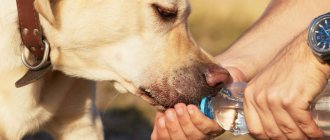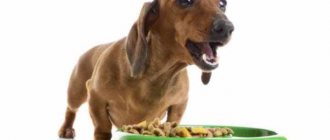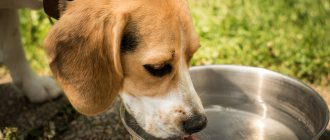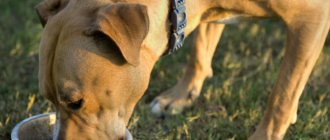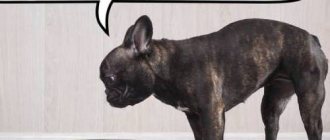Animals, like humans, can also have digestive problems. For example, a dog does not eat anything, is lethargic and apathetic - these are characteristic signs of indigestion. In such cases, a single vomiting is even useful, and is regarded by the body as a natural signal to cleanse the stomach. You should be concerned if the symptom is permanent. The condition is especially dangerous for a pet’s health when a reflex contraction of the stomach is accompanied by a specific composition of vomit against the background of increasing symptoms of intoxication, for example, weakness, apathy, loss of appetite, fever and dehydration.
Causes of lack of appetite
Lack of appetite in a pet is not yet a specific phenomenon for diagnosing a dangerous illness. There are several reasons for this behavior of the animal.
Causes of lack of appetite
- Reaction to the environment or weather. This is not uncommon for “apartment” dogs accustomed to other conditions.
- Depression and stress. A change in habitual lifestyle may be the cause of a dog’s lack of appetite during the adaptation period.
- Change in diet. Abrupt introduction of other foods can cause nutritional dysfunction.
- Food intolerance or allergy. Fatty foods are often the cause of gas formation. A protein allergy is diagnosed by symptoms of food refusal, vomiting and diarrhea.
- Side effect of the medicine. Long-term use of medications causes stomach irritation in the dog, which causes discomfort and, accordingly, loss of appetite.
- Sick teeth. A common cause of lack of appetite in older dogs.
- Disease. There are many types of digestive tract dysfunction where your pet refuses to eat due to nausea. Here it is important to quickly understand whether the symptom is one-time in nature or is a hidden sign of a serious pathology.
What tests will help determine the disease?
Clear and pronounced signs of gastric distress are a serious reason to contact a veterinarian as soon as possible. This will allow you to quickly determine the etiology and diagnose the disease at an early stage of development.
To identify the cause of the pathology, the veterinarian conducts a visual examination of the animal. Attention is paid to the oral cavity, the appearance of the dog and the condition of the lymph nodes.
To make an accurate diagnosis, blood tests and stomach contents are taken, an ultrasound examination is performed, and, if indicated, gastrointestinal endoscopy. If necessary, the doctor takes rectal and oral washes.
Diseases that cause lack of appetite
Diseases that provoke lack of appetite can be different, ranging from ordinary intestinal disorders to serious infectious infections.
For example, if your dog has isolated cases of refusal to eat, most likely the pet suffers from individual intolerance to one of the components of the diet. If the dog has one-time and rare signs of a disorder, then there is no need to worry too much. Most likely, the animal is simply cleaning its stomach.
A sure sign of worm infection is a symptom when the dog does not eat anything, but only drinks water and vomits. But this same sign of malaise, combined with nausea, can also mean the development of an infectious pathology, for example, plague, parvovirus enteritis, infectious hepatitis, rabies or aviary cough. In any case, the pet needs urgent qualified medical care for diagnosis and treatment.
In veterinary practice, the main causes of lack of appetite and vomiting in dogs are:
- improper diet;
- poor quality food;
- spoiled food;
- binge eating;
- entry of a foreign body into the esophagus or stomach;
- viral or cancer disease;
- chemical poisoning;
- ulcerative lesions of the gastrointestinal tract;
- hepatitis;
- weakness of the vestibular apparatus.
Intussusception
Intestinal obstruction is a serious pathology in which the pet dies if timely assistance is not provided.
Blockage may occur due to eating fragile bones.
The causes of intussusception are as follows:
- blockage of the intestines by foreign bodies;
- infringement;
- vascular embolism.
Blockage can occur due to eating fragile bones or when swallowing foreign objects - pieces of wire, pebbles, a piece of polyethylene. This type is called ileus. In children, blockage by crowded balls of worms is possible.
Incarceration may occur due to gastric torsion or strangulated hernia.
in the cavities of blood vessels , resulting in blockage of blood vessels and obstruction.
Symptoms
With gastric pathology, progressive vomiting is observed.
Pronounced signs occur with pathology of the stomach and duodenum.
With this development of events, progressive vomiting, complete apathy of the animal, and severe pain are observed. The patient's condition is rapidly deteriorating. Symptoms may only manifest in the form of general weakness and apathy, and occasionally vomiting. The further fate of the dog depends only on the speed of the owner’s reaction. Delay can be fatal.
Treatment
There is no drug solution to the problem. Intussusception can only be eliminated through surgery .
After surgery, the doctor prescribes anti-inflammatory drugs.
If necrosis of intestinal tissue is observed, the doctor performs a bowel resection. In the postoperative period, the doctor will prescribe anti-inflammatory drugs, antibiotics, and medications that support the patient’s general condition.
Vomiting with food refusal
Refusal to eat is the first sign that something is wrong with the dog. The symptom is often combined with nausea and vomiting. The cause of this pathology can be determined by observing the frequency, consistency and content of vomit.
Dog vomits bile
Yellow vomit may mean the stomach is being cleaned if the dog has been walking and eating grass before. Usually this urge is one-time, occurs on an empty stomach in the morning, and is not accompanied by other signs of malaise, for example, refusal to eat or intestinal dysfunction.
What should you do if your animal continues to vomit yellow for several hours? Take a closer look at the diet; your dog may have an excess of bile. Keep your pet on a diet. If the animal's condition has improved after vomiting, there is no particular reason for concern. Repeated vomiting and refusal to eat – the dog needs to be shown to a doctor to rule out a dangerous pathology.
If worms are visible in the vomit, the dog has serious problems and urgent medical attention is needed. The appearance of blood impurities in the vomit indicates an infectious disease of the gastrointestinal tract. If the pet is not given timely help, it will die.
The dog vomits white foam
The safest cause of such vomiting is the release of gastric mucus when air enters the gastrointestinal tract. In this case, vomiting is one-time and does not change the animal’s behavior.
Urging and vomiting white foam on an empty stomach indicates infection with helminths. The dog should be shown to a veterinarian and given deworming medication before admission.
Causes of repeated vomiting of white foam or liquid:
- Against the background of general malaise, lack of appetite and weakness, this is a clear symptom of gastroenterological problems associated with poor diet.
- Frequent foamy vomiting is a sign of severe intoxication of the body due to poisoning or the dog has swallowed a foreign object.
- Vomiting in combination with a complete refusal to eat, lethargy, apathy, severe shortness of breath and an increase in temperature indicates the development of an infectious disease (pancreatitis, hepatitis, plague, enteritis).
- Foamy vomiting may indicate central nervous system damage due to traumatic brain injury or heatstroke in a dog.
- In older pets, the symptom means renal failure due to prolonged drug intoxication.
It is important to know that you should not self-medicate; your pet’s life may depend on it. After clinical examinations and a thorough study of the disease history, the doctor will make an accurate diagnosis and prescribe the correct treatment.
The animal is vomiting blood
A dangerous sign that means internal bleeding due to the dog swallowing a sharp object or poisoning from rat poison. In rare cases, the appearance of blood in the vomit indicates a side effect of long-term use of strong antibiotics.
It is important to know that such a symptom is very dangerous for the health of the animal, so the dog should be shown to a doctor as soon as possible. If you cannot get an appointment quickly:
- provide your pet with peace;
- give the tablet Kvamatela;
- The pet needs constant drinking in small sips.
If, in combination with vomiting, the animal develops other symptoms - the dog lies motionless, refuses to eat and drink, the pet is lethargic and apathetic. Deterioration in general health against the background of rising temperature may have a viral etiology. In older animals, such symptoms often appear due to liver problems.
Even if the dog vomits blood just once, in order to exclude chronic pathology, take the dog to the veterinarian.
If your pet doesn't eat dry food
Dogs often like wet food, but it gets dirty and is more expensive than dry food, which is usually not a good choice for owners. Regardless of why you want to switch your pet to dry food, consult your veterinarian first. If the doctor approves your choice, you will need to slowly add dry food to wet food.
This will prevent your dog from getting stomach problems. During this time, it is recommended to eliminate any other food sources, such as human food or treats, so that you can evaluate whether the food is suitable for your dog or not.
What else can you do to make your dog willing to eat dry food?
- Change your diet slowly.
Switching your dog from wet food to dry food is not something you can do overnight. For best results and to avoid any digestive upset for your furry friend, take your time switching from one food to another. Although your dog may be resistant to the change at first, you can help him gradually get used to dry food. The way you present him at mealtimes will have a big impact on how he accepts the shift.
To enhance the flavor, you can lightly warm the croquettes in the microwave.
- Wet diet.
You can first mix the dry food with, for example, low-salt chicken or beef broth or a little tuna juice from a can, or regular canned dog food will also work. This will not only soften the food, but also improve the aroma and taste. To control the calories, you can use a mixture of warm water and broth or canned food.
- Warm water.
One way to make dry food more attractive is to add warm water. This will help to better reveal the taste and aroma of food and make it more appetizing. To begin, mix the food with just a few tablespoons of warm water and wait until the food is soaked. You can always add more liquid if you want the food to be softer - or if you want to mash it into a puree.
- Switch to higher quality food.
There are currently a huge number of different dry foods on the pet products market, which can vary significantly, including in quality. Super premium and holistic diets contain much more muscle meat and fewer carbohydrates than cheaper foods. If you've tried economy or mid-range dog food without success, try switching to a higher quality diet and experimenting with flavors until you find one your dog likes.
Remember that for some dogs, wet food is better than dry food. In addition, your veterinarian may recommend a raw diet or home-cooked diet if health conditions warrant it.
How to make a dog eat
Getting your dog's appetite back will largely depend on the underlying cause of the anorexia. Often, after solving this problem, the desire to eat food returns. Sometimes this may take several days and additional measures may be required. Depending on your dog's condition, your veterinarian may give an injection, tablet, or powdered food supplement to stimulate his appetite.
They need to be treated with caution, as they do not solve the problem - they simply make the animal want to eat. In some cases, if your pet is recovering or treatment lasts longer than a couple of days, doctors may suggest inserting a feeding tube (feeding tube). It goes into the esophagus so your dog can get liquid food through it. This is not forever - you just need to feed the dog until they start eating on their own.
If you are concerned about your dog's appetite, contact your veterinarian. Finding and treating the root cause is the best way to approach this situation.
Dog vomits after eating
There could be several reasons for this. With normal functioning of the intestines, food is digested 2 hours after entering the stomach. If your pet vomits undigested pieces of food 3-4 hours after feeding, the animal has a serious problem with the gastrointestinal tract. What could mean the presence of an inflammatory process in the intestinal area or the development of oncology if the dog is already aged.
Puppies often have a gag reflex when they overeat, when food begins to come out in undigested pieces. In this case, the baby must be provided with a daily diet, a sufficient amount of water, antispasmodics (Nosh-pa, Papaverine), antiemetic Cerucal and gastroprotective drugs (Omez, Smecta).
First aid in cases where a dog vomits after eating:
- diet;
- provide peace;
- give activated carbon 1 tablet per 10 kg of weight;
- for symptoms of indigestion - Enterosgel.
What to do if your dog is vomiting water
If the dog refuses to eat, constantly drinks only water and vomits immediately after drinking, these are clear signs of an infectious infection or serious intestinal dysfunction. Vomiting due to lack of appetite is considered the most dangerous symptom, since the animal’s body quickly loses nutritional reserves.
The pathology requires urgent contact with a veterinarian, otherwise the dog may die from dehydration within 2-3 days.
Before the veterinarian arrives, the dog needs to be given symptomatic care:
- make an enema with strained chamomile decoction;
- to prevent dehydration, inject saline solution subcutaneously at the rate of 5 ml per 1 kg of pet’s weight;
- give an intramuscular injection of Metaclopramide or Cerucal (1 ml per 10 kg of weight) to stop vomiting.
These measures are aimed at alleviating the pet’s condition and are not effective treatment. The pet requires urgent qualified help.
Parvovirus gastroenteritis
Parvovirus is the smallest virus that infects vertebrate animals.
Resistant to environmental influences, withstands low temperatures, adapts well to high temperatures. Only boiling kills the virus. All types of dogs are at risk of the disease, regardless of breed.
The main outbreak occurs in spring, continues in summer and autumn, and subsides in winter. Young individuals under the age of one year are more susceptible due to poorly developed immunity. But older dogs, when their immunity is already significantly weakened, are also at risk of becoming infected.
Young dogs are more susceptible to the disease.
The disease is spread by recovered pets and currently ill pets.
Peculiarities
The latent period of the disease can last up to three days.
- There are three periods of pathology - incubation, clinical and final periods.
- The latent period can last up to three days.
- As a rule, the disease occurs in two forms - gastroenteritis with myocarditis and gastroenteritis.
- By severity - mild, moderate and severe.
Symptoms
The severe course begins with absolute apathy.
- A mild degree is characterized by slight apathy, loss of appetite, diarrhea, and less commonly vomiting.
- The average degree is manifested in refusal to feed, diarrhea, constant vomiting, and abdominal pain.
- A severe course begins with absolute apathy, the animal does not react to external stimuli, constantly lies, does not eat, does not drink.
- Increased salivation is observed, body temperature rises, and fever begins. The pet constantly feels sick, with frequent progressive vomiting.
- The diarrhea then progresses and becomes debilitating, leading to severe dehydration.
- For small puppies, the pathology can result in death.
Treatment
Before the doctor arrives, you should take your temperature.
- Before the doctor arrives, you should take your temperature.
- Forcibly feeding and drinking is prohibited.
- If you have diarrhea and no vomiting, you can try to replenish lost fluid. To do this, prepare a solution: for one liter of boiled water, take 3.5 g of table salt, add baking soda in the amount of 2.5 g, potassium chloride in a dose of 1.5 g and sugar in the amount of 20 g. Give your pet small doses - 40 ml per kilogram of body weight. If you have Ringer-Locke solution in your house, you can replace it with this solution.
- Drug treatment is prescribed only by a doctor.
- The first sign of recovery is the appearance of appetite.
When to see a doctor
If your pet's gag reflex is one-time in nature against the background of general good health, there is no reason to worry. Does your dog often feel sick after a walk, but his behavior and well-being do not change? Observe the animal, where it walks and what it eats on the street.
Does your dog vomit after eating? We recommend showing your dog to a veterinarian to rule out the possibility of developing hidden chronic pathology or individual intolerance.
Over the last day, your dog’s health has worsened, a fever, diarrhea have appeared, and vomiting has become regular? This is a symptom that is dangerous to your pet’s health and you should immediately consult a veterinarian.
General preventive measures
As you know, the best treatment is good prevention. To avoid unpleasant surprises, you should be extremely attentive to your pets.
It is necessary to carefully monitor the quality of feed.
- Timely medical examination is the key to good health and well-being of your pet.
- It is necessary to carefully monitor the quality of food , do not take risks and do not experiment with new brands from unknown manufacturers.
- Always carefully study the composition and possible vitamin and mineral supplements .
- If you want to supplement your diet with useful substances , consult your doctor.
- Systematic deworming is of no small importance . It is necessary to periodically treat your dog for fleas and carefully inspect the skin for ticks.
- Eliminate access to household chemicals , poisons, and paint and varnish products.
- The dog's utensils and habitat must be systematically sanitized and disinfected .
- In addition, when arranging a place for an animal to live, one should exclude the possibility of drafts and dampness , as well as the possibility of overheating from direct sunlight.
